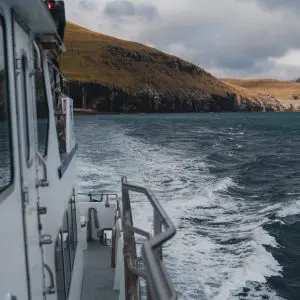A Local’s Guide to Car Insurance in Iceland: What Every Traveler Should Know

Driving in Iceland is one of the best ways to experience the country’s breathtaking landscapes, and a self-drive trip offers the ultimate freedom. But before you hit the road, it’s essential to understand how car insurance works in Iceland. Trust us, the weather and nature here play by their own rules.
As someone who live here and has spent years on the road, both for work and weekend escapes, we can say this with confidence: getting the right car insurance in Iceland is not just important, it’s necessary. Let us walk you through everything you need to know so you can focus on the scenery, not the stress.
Why car insurance matters so much in Iceland
Iceland’s landscape is stunning, but it can be harsh. The weather changes quickly, gravel roads are common outside of cities, and even experienced drivers can be caught off guard by wind gusts strong enough to rip a car door off. Yes, that happens here more than you’d expect.
Many travelers assume basic coverage is enough, but proper protection can save thousands of euros and a ruined vacation when driving in conditions unique to Iceland.
The basics: What’s included by default?
When you rent a car in Iceland, some insurance is already included in the base rental price. This usually covers:
- CDW (Collision Damage Waiver) – Reduces your financial liability if you damage the car. However, it still leaves you with a deductible that can range between ISK 200,000 and ISK 400,000 (roughly €1,300–€2,600).
- TP (Theft Protection) – Iceland is one of the safest countries in the world. Car theft is extremely rare, but this coverage is still standard.
That’s the minimum. But it’s far from complete.
Extra coverage you should seriously consider
Let’s break down the optional insurance add-ons that most locals would strongly recommend for foreign drivers:
SCDW (Super Collision Damage Waiver)
This reduces the deductible from hundreds of thousands of ISK to something more manageable, like ISK 50,000 or less. It’s worth it if you drive the Ring Road or plan a multi-day trip.
GP (Gravel Protection)
A must-have if you’re venturing beyond Reykjavík. Gravel roads are everywhere in Iceland, and stones easily kick up and chip windshields, headlights, and paint. GP covers these small but expensive damages.
SAAP (Sand and Ash Protection)
You won’t see this in many countries, but in Iceland, it’s crucial in the south and east, especially around Vík and the black sand areas. Volcanic ash and windblown sand can destroy paintwork, and CDW or SCDW doesn’t cover this damage.
TI (Tire Insurance)
Flat tires happen more often than you’d think on Icelandic roads. Regular CDW doesn’t cover punctures or roadside assistance.
WDI (Wind Damage Insurance)
Here’s a tip from a local: Never open your car door with one hand on a windy day. Strong gusts can literally bend your door backward. This is not covered under basic CDW and costs a fortune to repair. 
What about F-roads?
If you’re planning to drive on F-roads (mountain tracks only open in summer), you’ll need:
- A 4×4 vehicle, as it’s illegal and dangerous to drive these roads with a regular car.
- Check your rental agreement, as some companies don’t allow F-road access even in a 4×4 unless you’ve bought additional coverage.
- No insurance covers river crossings, as we have rivers without bridges. And no, your insurance won’t help if you flood the engine.
Seasonal considerations: When and what to insure
In Iceland, the time of year you visit significantly impacts driving conditions and the type of insurance you’ll need. Each season brings challenges and risks, and understanding these can help you choose the right protection and enjoy a smoother, safer trip.
Summer is the most popular time for self-drive tours, from June to August. The weather is generally mild, the roads are mostly clear, and even the highland F-roads are accessible during this window. This is the best season for exploring remote areas, but it comes with certain risks. Gravel roads are familiar once you get outside the city, and loose stones can easily chip windshields or paint. Gravel Protection becomes especially important in summer, as more travelers venture into the countryside. Sand and ash protection is also highly recommended: dry, windy conditions in the south can kick up volcanic ash that damages car exteriors.
Autumn, which runs from September to November, brings colder weather and shorter days. Conditions become more unpredictable, with a higher likelihood of heavy rain and early snow in some areas. During this time, strong winds are more frequent, especially in open regions like the Reykjanes Peninsula or the south coast. Wind Damage Insurance becomes particularly useful in the fall. It’s also the season when highland roads begin to close, so you must check weather and road condition updates regularly before you travel.
 Winter, from December through February, is the most challenging season for driving in Iceland. Roads can be icy, storms are common, and daylight hours are very limited, sometimes as few as four to five hours per day in the north. Winter driving in Iceland requires extra caution, even for locals. If you’re planning to drive a rental car in winter, make sure that Collision Damage Waiver (CDW) and Super Collision Damage Waiver (SCDW) are included. These will offer essential protection if you slip on icy roads or get caught in a snowstorm. Although most major roads are kept open and cleared, avoiding driving in remote or mountainous areas is strongly advised unless you’re experienced and well-prepared.
Winter, from December through February, is the most challenging season for driving in Iceland. Roads can be icy, storms are common, and daylight hours are very limited, sometimes as few as four to five hours per day in the north. Winter driving in Iceland requires extra caution, even for locals. If you’re planning to drive a rental car in winter, make sure that Collision Damage Waiver (CDW) and Super Collision Damage Waiver (SCDW) are included. These will offer essential protection if you slip on icy roads or get caught in a snowstorm. Although most major roads are kept open and cleared, avoiding driving in remote or mountainous areas is strongly advised unless you’re experienced and well-prepared.
Spring, from March to May, is a transitional period. Snow begins to melt, leading to wet, muddy, and unstable roads in rural areas. Melting ice often exposes gravel, so this is another time when Gravel Protection is highly recommended. Wind remains a concern during spring, particularly in April, when temperature shifts create turbulent conditions. It’s also a time when many travelers underestimate the weather, thinking spring is already mild, when in reality, blizzards can still occur well into April, especially in the north or the Westfjords.
No matter the season, reviewing your route and planning for the specific conditions you’re likely to face is a good idea. A trip to Reykjavík in midsummer requires very different coverage than a winter journey around the Ring Road. Choosing the right insurance based on the season is one of the smartest decisions you can make when planning a self-drive adventure in Iceland.
A few insider tips
Always take photos of the car before and after your trip. Even small scratches can become expensive without proof.
- Wind is your worst enemy. Park facing into the wind, and always open doors slowly.
- Use the SafeTravel app. It offers real-time road and weather alerts from the Icelandic authorities. This can help you avoid accidents and, therefore, claims.
- Don’t assume your travel insurance covers rental car damage. Most don’t.
Don’t drive off-road. It is illegal, and environmental damage is taken very seriously here. Fines are high. - Refuel when you can. In the countryside, gas stations can be far apart.
Watch out for sheep! They roam freely in summer, especially in the Westfjords and East Iceland.
Better safe than sorry
Iceland is one of the best countries in the world for a road trip. It’s safe, beautiful, and full of surprises around every corner. However, that wild nature can also cause unexpected problems on the road.
Our advice is simple: don’t cut corners on insurance. While it might seem like a way to save money, skipping the right coverage often costs travelers much more in the long run.
If you’re unsure which coverage to choose, ask your rental company or contact a local tour expert to create a self-drive tour package for you. We’re always happy to help you plan the trip of a lifetime, without any bumps along the way.










































